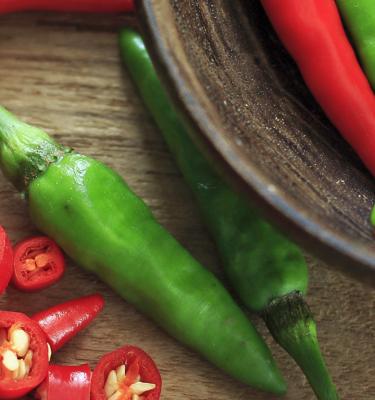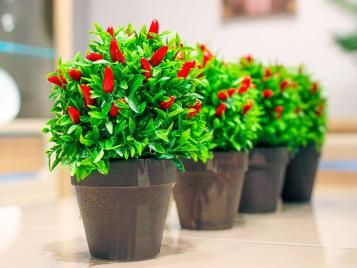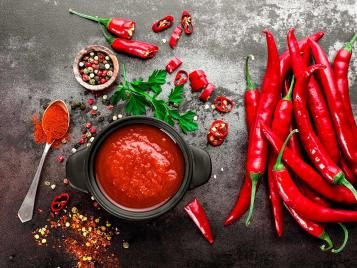

How To Grow and Care For Chilli Plants At Home In 7 Easy Steps
It seems that most people now have at a few chilli pepper plants at home - it’s become trendy, partly due to how easy they are to grow. Find out how to grow the freshest, tastiest chillies at home and save yourself time and money!
Growing chillies at home
To ensure a reliable crop, chilli peppers need a warm, sunny position outside or they can be grown in a greenhouse, grow frame or covered structure. Very hot chilli varieties are definitely better under cover, as this helps develop the intense heat, taste and flavour.
Although they can be grown in well-prepared, moisture-retentive soil, they usually crop better and more reliably if grown in containers.
Varieties of chilli pepper to grow
The following are all good reliable varieties of chilli:
- Apache
- Cayenne
- Demon Red
- Etna
- Fuego
- Habanero
- Hungarian Hot Wax
- Jalapeño
- Joe’s Long Cayenne
- Prairie Fire
- Super Chili
- Thai Hot Dragon
One of the hottest chillies you can grow at home is Dorset Naga, which is extremely hot.
The hotter the variety the longer the whole growing process will take (from germination through to ripening) so bear this in mind when selecting your preferred type.

Sowing chilli pepper seeds
You can sow seeds from February to April. It is usually better to sow as early as possible, even January if you’re growing very hot chillies, as they need a long summer to crop well.
Sow seeds at 18-21°C (65-70°F) in pots of good seed sowing compost. Transplant the seedlings individually into 9-10cm (3-4in) pots when two true leaves have formed, and grow them on at around 16-18°C (60-65°F).
Gradually harden off the plants for 10-14 days before planting outside.
- Soak chilli seeds overnight in warm water before planting OR gently sandwich between damp kitchen roll, place in a plastic bag and leave in the airing cupboard for a couple of days to improve germination.
- Chilli seeds love hot weather so, grow in a greenhouse or even in a pot on the kitchen window sill for a bit of extra heat to your chilli plants.
- Sow chilli seeds as early as possible (January or February for the hot varieties).
- Ideally sow chilli seeds at a temperature of between 18-21°C (65-70°F).
- Sow seeds in small pots and very shallow (about 5mm deep). Transfer to a larger pot when two leaves have developed, try not to touch the forming roots when re-potting to prevent accidental damage.
- Water regularly but don’t allow the soil to become waterlogged. Cover the seed tray with Vermiculite, it helps with water and heat retention, both of which the chilli seeds love.
- If planting seedlings outside gradually harden the seedlings off for 10-14 days (leave outside during the day and bring in over night).
- Feed with a chilli feed or seaweed extract.
How to care for your chilli plants
Plants are ready to put into their permanent cropping position once the roots fill the 9-10cm pots. Pot them up into 20-23cm (8-9in) pots of good compost in late April (if growing in a heated greenhouse), mid-May (unheated greenhouse) or late May/early June if growing outside. They can also be grown in growing-bags, but will need very careful watering.
Pinch out the growing tip when plants reach about 15-20cm (6-8in) high to encourage bushy growth and better cropping. You can also pinch back the sideshoots if lots of smaller chillies are needed.
Water regularly and feed with a balanced general feed, switching to a high potassium feed when the first chillies have set.
Mist the foliage regularly, especially under cover, with tepid water to discourage red spider mite and to improve cropping.
Looking after a chilli plant
- Chilli plants like growing in containers where the temperature can be easily regulated.
- If growing outside select a sunny, sheltered, well drained position. If growing inside a sunny window sill or conservatory is perfect, just remember - don’t let the soil dry out.
- Pinch out the growing tip when the chilli plant gets to about 20cm high - this encourages bushy growth and better crops.
- Feed with Tomorite every other week as soon as flowers start to appear.
- Pollination does need to occur to get fruits. Rub the bristles of a small paint brush, or your little finger, gently over the flower heads to ensure that pollination occurs. If growing outside the chances for natural pollination are higher so this is not necessary.
- Give at least 2 inches of water per week once the fruits have appeared, spray rather than water at the base to prevent over watering.
- Chilli plants grown indoors can be treated as perennial houseplants and will need a good prune in the winter months.
How to harvest your chillies
Pick the fruit as needed when it has reached a good size. You can either pick them when they’re green (when the flavour is quite mild) or leave them on the plants until they have turned red, which develops a stronger, hotter flavour.
Harvest your chillies by snipping the top of the stalk with sharp secateurs. Frequent harvesting of the fruits allows the chilli plant to devote it energies to developing more fruit.
Chillies can be dried or frozen for later use. Dried chillies make an interesting alternative for festive decorations.

Common chilli pests
Chilli plants can be susceptible to the following plant pests: Aphids, Whitefly and Red spider mite.
Key features of chilli plants
| Flowering season(s) | Summer |
|---|---|
| Foliage season(s) | Spring, Summer, Autumn |
| Sunlight | Full sun |
| Soil type | Chalky, Clay, Loamy, Sandy |
| Soil pH | Neutral |
| Soil moisture | Moist but well-drained |
| Ultimate height | Up to 60cm (2ft) |
| Ultimate spread | Up to 45cm (18in) |
| Time to ultimate height | 6 months |



